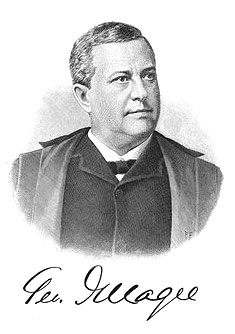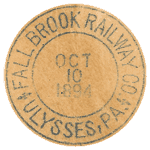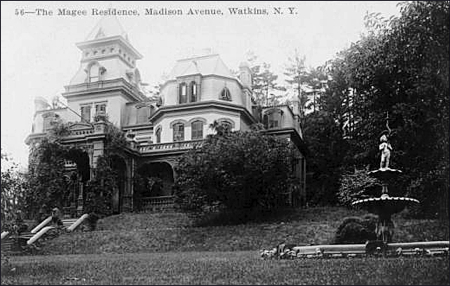
General George J. Magee
" Honored and respected by all,
there has been no resident of Schuyler county who has occupied a more important position in industrial and commercial circles than did
General George Jefferson Magee (b. 1840, d. 1897) of Watkins, not alone on account of the brilliant success he achieved, but also because of
the honorable, straightforward business policy he ever followed."*
Honored and respected by all,
there has been no resident of Schuyler county who has occupied a more important position in industrial and commercial circles than did
General George Jefferson Magee (b. 1840, d. 1897) of Watkins, not alone on account of the brilliant success he achieved, but also because of
the honorable, straightforward business policy he ever followed."*
On the death of his father John Magee, in June, 1868, General George Jefferson Magee became the vice president of the Fall Brook Coal Company and the Blossburg & Corning Railroad Company. (His military title was received in 1869 under appointment of Governor Hoffman to the position of Paymaster General of the State of NY.)
When his brother, Duncan S. Magee (who had become president of the Fall Brook interests on his father's death), passed away unexpectedly two years later, he assumed the presidency and control of the Magee and Fall Brook interests. General Magee also became a trustee of his father's estate, which included the ownership of the bituminous coal interests of the Fall Brook Coal Company in Tioga county, Pennsylvania, along with the railroad properties.
General Magee began his education in the public schools of Bath, which continued in Albany and in Lawrenceville, New Jersey, and in 1860 graduated from Princeton. He began his business career at the Steuben County Bank at Bath, and later became connected with the family's mining interests at Fall Brook, Pennsylvania. After broadening his horizons with a year-and-a-half of traveling in Europe, he returned to the office of the Fall Brook Coal Company in Watkins, New York, and immersed himself in his father's extensive business interests. The development and extension of these interests formed the life work of General Magee. Following the death of his father, he was instrumental in the completion of the Wellsboro & Lawrenceville Railroad in 1872, which had been started by his father.
The Blossburg and Corning and the Wellsboro and Lawrenceville were consolidated to form the Corning, Cowanesque and Antrim Railway Company, which was incorporated under the laws of New York and Pennsylvania in 1873. The Cowanesque Valley Railroad was purchased by the Corning, Cowanesque and Antrim in 1874.*
Also in 1874, Gen. Magee paid for the exploration of lands near the Clermont (PA) area, which was found to have considerable coal. The Buffalo Coal Company was founded, with GJM as President, and in 1874, The McKean and Buffalo RR Co. was incorporated. With an authorized capital stock of $400,000, this was a standard gauge road which would carry coal from the Clermont area, to Larabee on the Buffalo, New York and Philadelphia Ry. (BNY&P), a distance of 22.31 mi. George J. Magee was a director of the McK&B, as he was of the BNY&P.
Owing to the excessive rates of the Erie and Northern Central Railroads for carrying coal, in 1875 General Magee undertook an ambitious plan for the building of a railroad from Corning to Geneva, to provide cheaper outlet for the coal mined at Fall Brook, Antrim and Morris Run. The route could also avoid shipment via the Chemung Canal and by barge on Seneca Lake, a slow, cumbersome, expensive and seasonal process. But the panic of 1873, owing to the policies of President Grant, had brought very tight capital availability, so this construction was considered a very risky move at the time. And Magee's original contractors had failed. Gen. Magee, convinced of the wisdom of this new route, was reputed to have staked all of his holdings on the building of this line, including the mortgaging of the Fall Brook properties.
The Syracuse, Geneva and Corning Railroad was completed in 1877, not coincidentally making transportation of coal via the Chemung Canal a thing of the past. It was considered a great success and major coup for Gen. Magee.
The road is 58 miles in length, and was constructed at a cost of about $1,500,000. It was opened for business Dec. 10, 1877, and has met with a success even beyond the anticipations of the most sanguine. It passes through a wealthy country, heretofore comparatively isolated. It crosses the famous Watkins Glen, near its head, which is spanned by one of the finest specimens of railway architecture in the State. The bridge is 150 feet above the stream, and the highest railway bridge in the State, except Portage. The road has proved a substantial benefit to the country which it traverses as well as to the people of Corning, and the Fall Brook Coal Company, and its public-spirited progenitor, General George J. Magee, is entitled to much credit for his indefatigable efforts in building the road, and through whose untiring energy it has reached its present prosperous condition.**
In 1878, the Geneva and Lyons Railroad was completed, and immediately leased by General Magee, giving the Syracuse, Geneva and Corning - with its connection to the Fall Brook's Corning, Cowanesque and Antrim - a through line from their Pennsylvania coal fields to the NYC mainline at Lyons.
Through the building of this road, for which the New York Central furnished the rails, Gen. Magee came into closer business relations with William H. Vanderbilt, whom he induced to furnish funds for the building of the Pine Creek Railroad (Jersey Shore, Pine Creek & Buffalo) in 1882. In 1883, Cornelius Vanderbilt entered into a contract with General Magee to build the Beech Creek Railway (originally Beech Creek, Clearfield & South Western Railroad) allowing the Central access to the rich Clearfield Coal fields. Gen. Magee was General Contractor, and later a member of the Board of Directors and Executive Committee. All these, when linked together gave the Fall Brook interests through service from Lyons to the rich coal fields of Pennsylvania.***
But working closely with the New York Central & Hudson (Vanderbilt) interests became a double-edged sword. As the Vanderbilts became more concerned that their arch-competitor, the Pennsylvania Railroad, was rapidly controlling access to the rich coalfields of Pennsylvania, they initially assisted in the leasing of the Pine Creek Railway by the Fall Brook, to provide a complete link from New York Central and Hudson tracks in northern New York State, southward deep into the Pennsylvania coal region. Ultimately, the Vanderbilts attempted to take control of the Fall Brook lines, at one point by detouring freight from the Fall Brook lines. George Magee was adamantly opposed to the sale at the prices offered.
In 1892, perhaps under pressure from the Vanderbilts, the Fall Brook Companies separated their coal and rail interests. The newly formed Fall Brook Railway Company became successor to the CC&A, and leased the Pine Creek, Syracuse Geneva & Corning, and Geneva & Lyons Railroads. Total track approximately 257 mi. from the NYC&H main line at Lyons, NY, to the Philadelphia & Reading tracks at Williamsport, PA.
The 15-mile-long railroad line he had taken over at his father's death, capitalized at less than five hundred thousand dollars, owned ten locomotives and a small number of cars. Under his auspices it came to own about one hundred miles of track with a capital stock of five million dollars, seventy-six locomotives and three thousand three hundred cars used in operating two hundred and fifty miles of owned and leased lines. The old Blossburg Railroad had become the Fall Brook Railway, reaching from the New York Central & Hudson River Railroad at Lyons, NY, to Williamsport, Pennsylvania, connecting with the Philadelphia & Reading road.
George J. Magee died in Nice, France, in 1897 while on his way to Egypt "in search of health." Pressure from the Vanderbilt interests to sell the Fall Brook Railroad, which he staunchly resisted, was thought in the family to have hastened his death. He was succeeded as president of the coal and railway companies by his son, John Magee. In 1899 the Fall Brook Railway Company, the Syracuse, Geneva and Corning Railway Company, and the Pine Creek Railway Company were leased by John Magee to the New York Central and Hudson River Railroad for 999 years. This became their "Pennsylvania Division." In 1909 these three roads were purchased and consolidated to form the Geneva, Corning and Southern Railroad Company which was immediately leased to the New York Central. The Fall Brook Coal Company continued briefly into the 20th century.
 General
Magee amassed extensive business interests: He was the president of the Fall Brook Coal Company; the Fall Brook
Railroad; the Morris Run Coal Mining Company; the Tioga Improvement Company; Buffalo Coal
Co. (and their railroad property the McKean and Buffalo - whose Engine #3 was named Geo J. Magee - see
below); Syracuse, Geneva & Corning Railroad Company. He was vice president of the Pine Creek Railroad.
He was a director of the Chest Creek Land & Improvement Company, of Cambria county, Pennsylvania; the
Beech Creek Cannel Coal Company, of Clearfield county, Pennsylvania; the Beech Creek Railroad (in the
acquisition of which he was joined by William K. Vanderbilt, foreshadowing the future acquisition of the Fall Brook interests by the
NYC&H); the Central Dock & Terminal Company of Buffalo, New York; the North River Coal & Wharf
Company, of Jersey City; and of the Knickerbocker Trust Company, of New York city.
General
Magee amassed extensive business interests: He was the president of the Fall Brook Coal Company; the Fall Brook
Railroad; the Morris Run Coal Mining Company; the Tioga Improvement Company; Buffalo Coal
Co. (and their railroad property the McKean and Buffalo - whose Engine #3 was named Geo J. Magee - see
below); Syracuse, Geneva & Corning Railroad Company. He was vice president of the Pine Creek Railroad.
He was a director of the Chest Creek Land & Improvement Company, of Cambria county, Pennsylvania; the
Beech Creek Cannel Coal Company, of Clearfield county, Pennsylvania; the Beech Creek Railroad (in the
acquisition of which he was joined by William K. Vanderbilt, foreshadowing the future acquisition of the Fall Brook interests by the
NYC&H); the Central Dock & Terminal Company of Buffalo, New York; the North River Coal & Wharf
Company, of Jersey City; and of the Knickerbocker Trust Company, of New York city.
In 1865 Gen. Magee was married to Emma Stothoff, of Burdett, New York. They had seven children: Anna Stothoff, John (who succeeded him in the Fall Brook interests), Kathleen (died in 1880 at age of 9), Stewart, Arabella Helen, Emma Marie, Lusyd and George Jefferson. He was a member of a number of leading NY clubs, including the Lawyers, the University, the Manhattan and the Princeton Clubs. His military title was received in 1869 under appointment of Governor Hoffman to the position of paymaster general of the state of New York.
General Magee's home, "Glenfeld," overlooking Seneca Lake in Watkins, was considered one of the finest in Schuyler County, and was the scene of numerous gatherings and galas:
On Tuesday evening last, Gen. Geo. J. Magee entertained the following distinguished guests at dinner, in his elegant residence, "Glenfeld," in this village: Wm. H. Vanderbilt, Cornelius Vanderbilt, W. K. Vanderbilt, Captain J. H. Vanderbilt, Foster Dewey, Wm. Turnbull and Samuel Barton, of New York city; J. H. Rutter, president of the N. Y. Central and H. R. Raiways; C. M. Depew, Second Vice-President of the same; Franklin B. Gowen, of the Philadelphia and Reading Railroad; H. McK. Twombly, of the Southern Pennsylvania Railroad; General Simon Cameron and James Duffy, of Pennsylvania; E. Ellis of the Schenectady Locomotive Works; A. Lathrop, of Corning, and C. J. Langdon, of Elmira. (Watkins Express - September 12, 1883)
The residence is a large modern-style and substantially built structure, delightfully situated, elegantly finished outside and in, and splendidly furnished. The grounds embrace an area of about ten acres, and are located on the principal residence thoroughfare of the village, Madison Avenue, just south of a romantic little wooded glen. The front to the east, and wide and charmingly picture landscape overlooking Seneca Lake, are complete in all things, additional to the residence, pertaining to the ideal of domestic life, namely: a massive enclosing sandstone coping, from the quarries at Antrim, Pa., and good for hundreds of years; wide, grassy lawns and costly fountains; a grove of tall, white pines; many ornamental shade trees; choice shrubs, plants and roses; flower, fruit and vegetable gardens; conservatories and a green-house for early delicacies; a cold fruit storage house; water-works, ice house and boat house; a forest tree shade nursery; a prospective billiard room and bowling alley; a new, commodious and remarkable combined $25,000 barn, stable and carriage house, and many features not herein mentioned. (Watkins Express - January 2, 1888)
* compiled or directly quoted from A Biographical Record of Schuyler County, New York, The S. J. Clarke Publishing Company, 1903, pages 223-225
** quoted from History of Tioga, Chemung, Tompkins & Schuyler Counties New York, 1879
*** compiled or directly quoted from The Colliery Engineer: Mines and Minerals, The International Textbook Co., Scranton, PA, 1906
... MORE ...
In 1874 General George J. Magee paid for the exploration for coal near Clermont, PA (McKean County), and founded the Buffalo Coal Company. Magee was chosen President. Other stockholders included Byron and O.J. Hamlin, Daniel Beach, and John Lang. Magee and the Hamlins organized the McKean and Buffalo Railroad (McK&BRR), to carry Clermont coal north from their Gum Boot Mine. In 1875, the McKean and Buffalo R.R., ordered their locomotive #3, a 2-6-0 Consolidation from Brooks Locomotive. It was named Geo J. Magee.
Syracuse, Geneva and Corning Railway
Ten years ago Gen. Magee projected the railroad
from Corning to Geneva, and thence to Lyons, to deliver his coal to the Central Hudson road. Innumerable obstacles presented themselves, but
he devoted himself to the work with such ability, tact and energy, that the enterprise soon became an accomplished fact. Having been the
originator and organizer, he is now the President of the road. The appearance and personal magnetism of General Magee are remarkable. His
success has been brought about in no small degree by the complete mastery of every detail of the vast business both of the railroad lines he
manages and the coal companies in which he is a principal owner or stockholder. He is frank and open as the day, alert in manner, with a
handsome form and face, his eyes are bright and full, and his conversation is marked by power and vivacity. An officer of one of the lines of
which the General is President remarked to the writer, that he believed George J. Magee knew every curve, tangent and side-track on the
entire system, and that not an employee of the company was half so well acquainted as he with the minutest detail of the road-bed, rolling
stock, operation, business and management of the lines under his direction ... Finely educated and well schooled in his duties, of strong
sense and indomitable energy, he is the ideal rail road President of this time. (Corning Journal - November 24, 1887)
Resolved: That the friends of the Syracuse, Geneva & Corning Railway owe its conception, its construction, and its operation to the foresight, the indefatigable labors, and the public spirit of Gen. Geo. J. Magee, its President , and President of the Fall Brook Coal Co. (Resolution adopted by the citizens of Corning - Corning Journal, December 13, 1877)
Vanderbilts Scheming - Trying to Force a Sale to the Fall Brook Road by a
"Freeze-out."
It is announced that the Vanderbilts are trying to obtain immediate possession of the Fall Brook
railroad, which runs from Lyons, to where it connects with the New York Central, to Newberry Junction, Pa., connecting with the Reading
railway, a distance of 250 miles.
![]() It is said that the Vanderbilts offered
General McGee(sic) of Watkins a large sum for instant possession, but the General refused, and placed a figure far above theirs. As a result
the Vanderbilts, it is said, are working on a freeze-out on the road, in conjunction with the Reading, shipping hard coal over the Lehigh
Valley instead of the Fall Brook, as formerly.
It is said that the Vanderbilts offered
General McGee(sic) of Watkins a large sum for instant possession, but the General refused, and placed a figure far above theirs. As a result
the Vanderbilts, it is said, are working on a freeze-out on the road, in conjunction with the Reading, shipping hard coal over the Lehigh
Valley instead of the Fall Brook, as formerly.
![]() This has greatly affected the
earnings, and over 100 men have been laid off. It is the intention of the Vanderbilts to amalgamate the Fall Brook with the Beach Creek,
thus, with the Reading, controlling the coal trade of Pennsylvania. (Syracuse Herald - Dec. 9, 1896)
This has greatly affected the
earnings, and over 100 men have been laid off. It is the intention of the Vanderbilts to amalgamate the Fall Brook with the Beach Creek,
thus, with the Reading, controlling the coal trade of Pennsylvania. (Syracuse Herald - Dec. 9, 1896)
Anton Hardt writes about George J. Magee
In a paper read before the Tioga County Historical Society
at Wellsboro, Pa., April 15th, 1909, by Anton Hardt, of Wellsboro, Pa., Mr. Hardt describes George J. Magee:
"I met George J. Magee for the first time Nov. 22, 1867, at Fall Brook. He was then a director of the Fall Brook Coal Company, whose business was mainly managed by his father, John Magee, and by his elder brother, Duncan S. Magee.
After John Magee's death, In 1868, Duncan S. Magee became president. His untimely death, in 1869, put the heavy load of the presidency on the shoulders of George J. Magee, who was then only 29 years old, and practically unprepared for such a responsible position. He had a fine college education, but had had very little to do with the affairs of the Fall Brook Coal Company. Unfortunately, soon after his election to the presidency, times began to tighten, the annual sales of Fall Brook coal decreased steadily, and prices went down so low that after paying toll to the Tioga Railroad, to the Erie and to the Northern Central the coal had to be sold at Watkins at a very small profit. Mr. Magee tried to have the railroads reduce their tolls, but they relied on traffic contracts with the Fall Brook Coal Company, which were made during the war, when coal sold at $12 a ton. Early in 1874 Mr. Magee felt convinced that a new outlet for the coal traffic would have to be found. During that year, he negotiated with the owners of a charter for a railroad from Corning to Sodus Bay, but after close investigation this did not prove satisfactory, and in the fall of 1875 surveys for a line from Corning to Geneva were begun. In 1876 contracts were let for the building of the road. The contractors failed and Mr. Magee himself had to take the contract. To raise funds for this purpose the whole property of the Fall Brook Coal Co. in Tioga county had to be mortgaged, and finally the Syracuse, Geneva & Coming railway from Corning to Geneva was completed, in the fall of 1877.
Few outsiders knew of the feverish anxiety which prevailed among the head men of the Fall Brook Coal Co. during the years '77, '78 and '79, and it took strong hands to guide the affairs of the company. Mr. Magee was equal to the emergency and was faithfully supported by Hon. Daniel Beach and Mr. John Lang. I remember meeting a prominent business man of Penn Yan early in 1877, who said to me: "General Magee's scheme of building a railroad from Corning to Geneva will fail and he will bankrupt the Fall Book Coal Co." This prediction did not become true; on the contrary, the building of the S. G. & C. R. R. was the making of the Fall Brook Coal Co.
Construction of the Pine Creek R. R. by General Magee followed, in 1882, and with the completion of that road, in 1883. the Fall Brook traffic increased very largely.
The New York Central soon found out that the Fall Brook system was the best feeder of their main line, and in 1895 the first effort was made to set a price on the property of the Fall Brook Railroad Co. Under enormous pressure from the Vanderbilts, General Magee knew that eventually he would be forced to sell out, and this knowledge preyed on his mind, and I believe hastened his death, which occurred March 11, 1897.
Hardly a day passes now but I am reminded of General Magee by some incident in business or social life. For nearly thirty years I worked under him, and was always treated by him with great kindness and consideration. It was characteristic of General Magee that he never showed his authority in a harsh way, but always tried to encourage his subordinates by helpful suggestions and brought about the best results In that way. He was loved and respected by all of his employees, and his memory will ever be cherished by them." (The History of The Railroads of Tioga County - Anton Hardt, 1908)

George J. Magee residence, "Glenfeld"
Madison Ave., Watkins, NY
Postcard
Thanks to Jim Treakle
